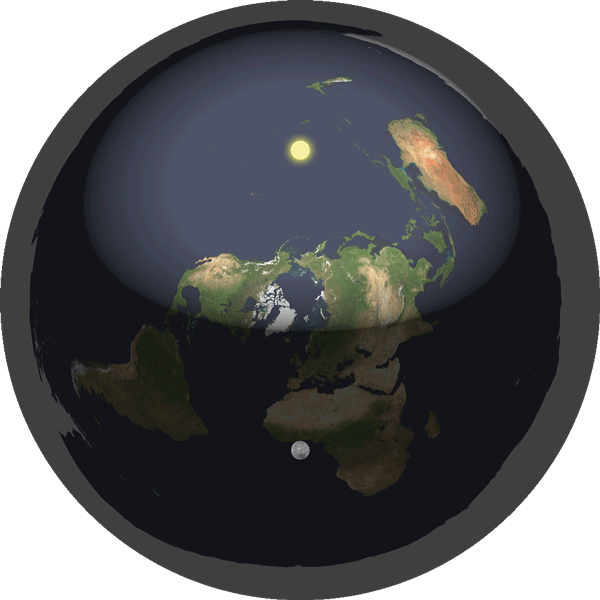Hey there,
This isn't by any means an attempt to um...display the ignorance of those of the Flat Earth Society, but rather a serious challenge based on the very same materials found within your wiki and common home appliances.
First, I present to you a picture found on the wiki which explains the rotation of the sun and the moon according to those who believe in this theory.

Now, in your own home do we not use lamps and lights to light up the room? Surely we've seen that, if you hold a light close to the surface of the floor, everything is dark, very similar to the picture above. But you have to hold it very close because your floor is flat, and the light spreads quite fast the farther up you go.
Based on this simple 5 year old experiment, you can see that the higher you lift the lamp, and this is by the way empirical evidence which is the foundation of the Flat Earth Theory, the farther the light spreads. Taking into account the size of the "flat" earth, even being a flat disc as portrayed, in order for the sun to rotate according to the picture above, it would need to be very very close to the earth in perspective.
Now. Lets stick our hand in the light of the shadow. You see a shadow of your hand right? The closer to the opposite surface away from the light you go, the smaller the shadow! Amazing, and completely empirical! Everyone can do this one too! Now...the closer to the light you go, the greater the shadow, right? Ok stay with me...we're getting complicated now. Based on this empirical evidence of shadow, and combined with what we know of how light spreads the further you it is from the surface of the object, be it the earth or your living room floor, the wider the effect. It doesn't take much to completely light up the entire house! Thus, when you see a plane flying you can sometimes see a shadow - and it's a very small shadow in comparison to the world and it's so very high up. Thus, the sun must be significantly further away! But hold up, if that were the case, due to the height of the sun in order for this to happen, the whole earth should be lit up all the time! Especially if it's flat! (With the exception of shadows from mountains and valleys).
Also, let's take in the size of the Sun - it's quite small really - and if it was so far away, how has it burned for as long as it has without running out of fuel? Surely it can't be all that big if it's so close to the earth as to only light up a small portion of it right? Again, try out the 5 year old experiment above for empirical evidence.
Thus, based on pure observation and empirical evidence and not a shred of actual scientific evidence, but pure 100% observation that any child can figure out, the world can't possibly be flat. My challenge is to argue this, but here's the deal! Before you can argue it, you HAVE to try the experiment above, and share your results. Then by all means argue.
"Nothing in all the world is more dangerous than sincere ignorance and conscientious stupidity." - Martin Luther King, Jr.
"Only two things are infinite, the universe and human stupidity, and I'm not sure about the former." - Albert Einstein
"I am patient with stupidity but not with those who are proud of it." - Edith Sitwell